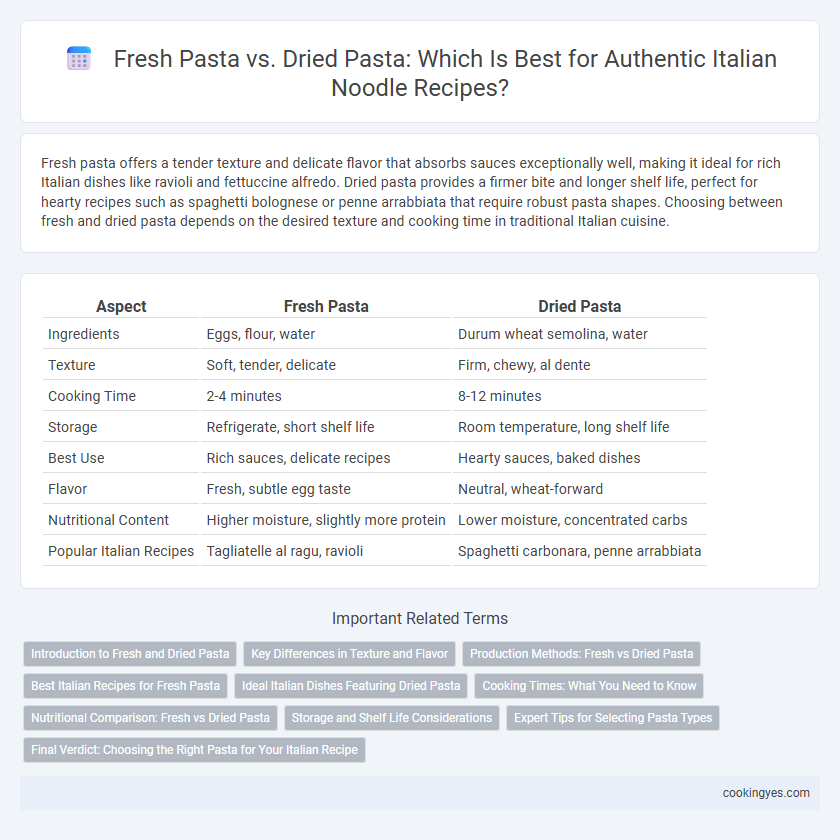Fresh pasta offers a tender texture and delicate flavor that absorbs sauces exceptionally well, making it ideal for rich Italian dishes like ravioli and fettuccine alfredo. Dried pasta provides a firmer bite and longer shelf life, perfect for hearty recipes such as spaghetti bolognese or penne arrabbiata that require robust pasta shapes. Choosing between fresh and dried pasta depends on the desired texture and cooking time in traditional Italian cuisine.
Table of Comparison
| Aspect | Fresh Pasta | Dried Pasta |
|---|---|---|
| Ingredients | Eggs, flour, water | Durum wheat semolina, water |
| Texture | Soft, tender, delicate | Firm, chewy, al dente |
| Cooking Time | 2-4 minutes | 8-12 minutes |
| Storage | Refrigerate, short shelf life | Room temperature, long shelf life |
| Best Use | Rich sauces, delicate recipes | Hearty sauces, baked dishes |
| Flavor | Fresh, subtle egg taste | Neutral, wheat-forward |
| Nutritional Content | Higher moisture, slightly more protein | Lower moisture, concentrated carbs |
| Popular Italian Recipes | Tagliatelle al ragu, ravioli | Spaghetti carbonara, penne arrabbiata |
Introduction to Fresh and Dried Pasta
Fresh pasta offers a soft texture and rich flavor due to its higher moisture content, making it ideal for delicate Italian recipes such as tagliatelle and ravioli. Dried pasta, processed by removing moisture, provides a longer shelf life and firmer texture, suitable for robust sauces in dishes like spaghetti bolognese and penne arrabbiata. Understanding the differences between fresh and dried pasta enables chefs to select the perfect noodle type for authentic Italian culinary results.
Key Differences in Texture and Flavor
Fresh pasta offers a tender, silky texture that absorbs sauces quickly, enhancing rich and delicate Italian recipes. Dried pasta features a firm, al dente bite with a more concentrated, nutty flavor ideal for robust sauces and longer cooking times. Choosing fresh or dried pasta significantly impacts the dish's mouthfeel and flavor profile, aligning with traditional Italian culinary techniques.
Production Methods: Fresh vs Dried Pasta
Fresh pasta is made from a simple mixture of flour and eggs, kneaded and rolled thin before being cooked or dried, resulting in a tender texture ideal for delicate sauces in Italian cuisine. Dried pasta undergoes a dehydration process after shaping, allowing for longer shelf life and firmer texture, which holds up well with robust sauces in traditional Italian recipes. The production methods influence cooking times, with fresh pasta requiring minutes to cook while dried pasta typically needs longer boiling to achieve the desired al dente consistency.
Best Italian Recipes for Fresh Pasta
Fresh pasta, made from eggs and soft wheat flour, offers a tender texture and delicate flavor ideal for classic Italian recipes like Tagliatelle al Ragu and Tortellini in Brodo. Its porous nature allows sauces like creamy Alfredo or rich Bolognese to cling more effectively, enhancing the overall taste profile. Best Italian recipes for fresh pasta emphasize simple, high-quality ingredients that highlight the pasta's natural freshness and texture.
Ideal Italian Dishes Featuring Dried Pasta
Dried pasta excels in classic Italian dishes like spaghetti alla carbonara, penne arrabbiata, and lasagna, where its firm texture holds up well to rich sauces and prolonged cooking times. Its low moisture content provides a longer shelf life and a more consistent bite, ideal for hearty recipes requiring boiling and baking. Choosing dried pasta ensures optimal absorption of tomato-based sauces and robust flavors in traditional Italian cuisine.
Cooking Times: What You Need to Know
Fresh pasta typically cooks in just 2 to 4 minutes due to its higher moisture content and delicate texture, making it ideal for quick Italian recipes like tagliatelle and ravioli. Dried pasta, with its lower moisture and denser structure, requires a longer boiling time of 8 to 12 minutes, suitable for robust sauces in recipes such as spaghetti Bolognese. Understanding these cooking times helps maintain the perfect al dente texture essential for authentic Italian pasta dishes.
Nutritional Comparison: Fresh vs Dried Pasta
Fresh pasta typically contains higher moisture content and fewer preservatives, resulting in a softer texture and faster cooking time, but it can have slightly lower shelf life compared to dried pasta. Dried pasta offers a more concentrated nutrient profile per serving due to its reduced water content, often providing more fiber and protein, which benefits sustained energy levels in Italian recipes. Both fresh and dried pasta varieties contain similar carbohydrate levels, but fresh pasta may retain more vitamins like B vitamins, affected by the drying process in dried pasta.
Storage and Shelf Life Considerations
Fresh pasta contains higher moisture content, requiring refrigeration and lasting about 1-2 days before spoilage, making it less suitable for long-term storage. Dried pasta, with moisture reduced to below 12%, can be stored at room temperature for up to 1-2 years, providing convenience and extended shelf life for Italian recipes. Choosing between fresh and dried pasta depends on storage capabilities and desired freshness in cooking.
Expert Tips for Selecting Pasta Types
Fresh pasta offers a tender texture and quicker cooking time, making it ideal for delicate sauces like Alfredo or simple olive oil dressings. Dried pasta, praised for its firm bite and longer shelf life, excels in hearty, slow-cooked sauces such as Bolognese or arrabbiata. Expert chefs recommend matching pasta shape and texture to the sauce consistency, using fresh varieties for light, creamy dishes and dried pasta for robust, chunky recipes to achieve authentic Italian flavors.
Final Verdict: Choosing the Right Pasta for Your Italian Recipe
Fresh pasta offers a tender texture and delicate flavor ideal for light sauces and quick cooking Italian recipes, while dried pasta provides a firmer bite and longer shelf life suited for robust sauces and slow-simmered dishes. Selecting the right pasta depends on the recipe's sauce type, cooking time, and desired mouthfeel to achieve an authentic Italian culinary experience. Incorporating fresh pasta enhances delicate recipes like tagliatelle alfredo, whereas dried pasta excels in hearty meals such as spaghetti Bolognese or penne arrabbiata.
Fresh pasta vs Dried pasta for Italian recipes Infographic

 cookingyes.com
cookingyes.com